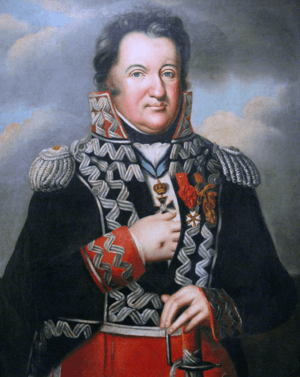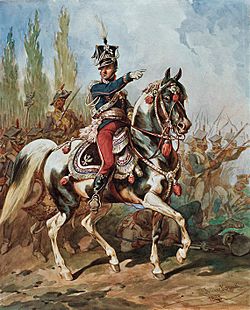Jan Henryk Dąbrowski facts for kids
Quick facts for kids
Jan Henryk Dąbrowski
|
|
|---|---|

|
|
| Born | 2 August 1755 Pierzchów, Poland |
| Died | 6 June 1818 (aged 62) Winna Góra, Posen, Prussia |
| Allegiance | |
| Service/ |
Cavalry |
| Years of service | 1770–1816 |
| Rank | General of Cavalry |
| Battles/wars | Kościuszko Uprising War of the Second Coalition Battle of Trebbia Battle of Friedland Russian Campaign Battle of Leipzig |
| Awards | Order of Virtuti Militari Order of the White Eagle Officer of the Legion of Honour Order of the Iron Crown Order of St. Vladimir Order of St. Anna |
| Other work | Senator of Congress Poland |
| Signature | |
Jan Henryk Dąbrowski (Polish pronunciation: [ˈjan ˈxɛnrɨɡ dɔmˈbrɔfskʲi]) was a famous Polish general and important leader. He is remembered as a national hero who worked his whole life to make Poland an independent country again.
Dąbrowski first served in the army of Saxony, a German state. In 1792, he joined the army of the Polish–Lithuanian Commonwealth. Soon after, Poland was divided by other countries. He became a general during the Kościuszko Uprising in 1794, which was a fight for Poland's freedom.
After Poland lost its independence completely, Dąbrowski worked hard to bring it back. He created the Polish Legions in Italy in 1795, which were Polish soldiers fighting alongside Napoleon Bonaparte. As a general for France and Italy, he helped create a small Polish state called the Duchy of Warsaw in 1806. He fought in many Napoleonic Wars, including the French invasion of Russia.
After Napoleon's defeat, Dąbrowski became a senator in Congress Poland, a new Polish state controlled by Russia. He also helped organize its army. The Polish national anthem, "Poland Is Not Yet Lost", even mentions Dąbrowski by name. It is also known as "Dąbrowski's Mazurka".
Contents
Early Life and Military Training
Growing Up in Saxony
Jan Henryk Dąbrowski was born in Pierzchów, Poland, on August 29, 1755. His parents were Jan Michał Dąbrowski and Zofia Maria Dąbrowska. He grew up in Hoyerswerda, a town in Saxony, where his father was a colonel in the Saxon army.
Dąbrowski joined the Royal Saxon Horse Guards in 1770 or 1771. Even though his family was Polish, he grew up with German culture in Saxony. He even signed his name as Johann Heinrich Dąbrowski. He fought in the War of the Bavarian Succession (1778–1779). In 1780, he married Gustawa Rackel. He lived in Dresden and slowly moved up in rank. By 1789, he was a captain. From 1788 to 1791, he worked for King Frederick Augustus I of Saxony.
Military Career and Polish Independence
Joining the Polish Army
The Polish parliament, called the Four-Year Sejm, asked all Poles serving in other countries to come back and join the Polish army. Dąbrowski saw little chance to advance in Saxony's peaceful army. So, on June 28, 1792, he joined the Army of the Polish–Lithuanian Commonwealth. He quickly became a vice-brigadier. He joined during the last weeks of the Polish–Russian War of 1792 but did not fight in it.
Dąbrowski was known as an expert in cavalry, which are soldiers who fight on horseback. King Stanisław August Poniatowski wanted Dąbrowski to help make the Polish cavalry more modern. Dąbrowski had studied at a military school in Dresden. In January 1793, he fought briefly against Prussian forces entering Poland. This happened after the Second Partition of Poland, when parts of Poland were taken by other countries. After this, Dąbrowski became a strong supporter of continuing the fight for Poland's freedom.
The Kościuszko Uprising
Dąbrowski was not involved in planning the Kościuszko Uprising, a big rebellion for independence. But when the uprising began, he quickly supported it. He helped defend Warsaw and led a group of soldiers in Greater Poland. Tadeusz Kościuszko, the leader of the uprising, praised Dąbrowski's bravery and made him a general.
Fighting with Napoleon's Army
After the uprising failed, Dąbrowski tried to convince the Prussian leaders that they needed Poland as an ally. He was not successful. With the Third Partition of Poland, Poland disappeared from the map of Europe. Dąbrowski then decided to ask the French Republic for help. He wanted France to support Poland and create a Polish army.
This idea worked! Dąbrowski is famous in Poland for organizing the Polish Legions in Italy during the Napoleonic Wars. These Legions are sometimes called "Dąbrowski's Legions." This gave hope to Poles, and it is still remembered in the Polish national anthem.
Dąbrowski started his work in 1796. He met Napoleon Bonaparte in Milan. On January 7, 1797, he was allowed to create Polish legions. These legions would be part of the army of the new Republic of Lombardy.
Dąbrowski wanted to lead his troops to Polish lands, but Napoleon used them to fight in Italy instead. Dąbrowski's Polish soldiers fought with Napoleon from May 1797 until early 1803. He was an important commander in the war in Italy. He entered Rome in May 1798 and fought bravely at the Battle of Trebia in June 1799, where he was wounded.
Dąbrowski also got some special items from Rome. These were trophies that the Polish king, Jan III Sobieski, had sent there after his victory over the Ottoman Empire in 1683. One of these was an Ottoman flag, which became part of the Legions' colors.
However, the legions never reached Poland to free the country, which was Dąbrowski's dream. Many Polish soldiers became unhappy when France signed a peace treaty with Russia in 1801. This treaty ended Polish hopes that Napoleon would free Poland. Thousands of legionnaires also died when they were sent to fight in the Haitian Revolution in 1803. By then, Dąbrowski was no longer leading the Legions.
Service in the Duchy of Warsaw
Dąbrowski continued to serve as a general for the Italian republic. In 1804, he received the Officer cross of the Legion of Honour. The next year, he received the Italian Order of the Iron Crown.
In 1806, Napoleon called Dąbrowski again. He wanted Dąbrowski to create a new Polish army to take back Greater Poland from Prussia. This led to the Greater Poland Uprising (1806), and Dąbrowski was a main leader of the Polish forces. He fought well at the siege of Tczew, the siege of Gdańsk, and the Battle of Friedland.
In 1807, the Duchy of Warsaw was created. This was a Polish state that was closely linked to Napoleon's France. Dąbrowski was disappointed that Napoleon did not give him a big military or government job. However, he did receive the Virtuti Militari medal that year.
In 1809, he helped defend Poland against an Austrian invasion. He fought in the Polish-Austrian war under Prince Józef Poniatowski. Dąbrowski then helped organize the defense of Greater Poland.
In June 1812, Dąbrowski led a Polish infantry division during Napoleon's invasion of Russia. But by October, the war was going badly for France. The French army was badly hurt by the severe winter and had to retreat. At the terrible Battle of Berezina in November, Dąbrowski was wounded. His leadership was criticized by some. After the army was reorganized, he commanded another Polish infantry division. He led it at the Battle of Leipzig in 1813. After this battle, he became the main commander of all remaining Polish forces serving Napoleon.
Later Life and Legacy
Final Years and Retirement
Dąbrowski always believed that an independent Poland needed its own army. So, he offered his skills to Russia, which promised to create such an army. The Russian Tsar Alexander I asked Dąbrowski to help reorganize the Duchy of Warsaw's army into the Army of Congress Poland.
In 1815, Dąbrowski became a general of cavalry and a senator in the new Congress Poland. He also received the Order of the White Eagle. Soon after, he left active politics. He retired in 1816 to his home in Winna Góra. He died there on June 6, 1818, from pneumonia and gangrene. He was buried in the church in Winna Góra.
Over the years, Dąbrowski wrote several books about military topics, especially about the Legions. He wrote them in German, French, and Polish.
How He Is Remembered
At first, some people criticized Dąbrowski. But over time, his reputation grew. He is often compared to other Polish military heroes like Tadeusz Kościuszko and Józef Poniatowski. He is also seen as a very important figure, like Józef Piłsudski, who helped create the Second Polish Republic.
His mention in the Polish national anthem, "Dąbrowski's Mazurek," made him very famous in Poland. Today, many history books call him a national hero. Dąbrowski is also remembered outside of Poland. His name, "Dombrowsky," is written on the Arc de Triomphe in Paris.
Images for kids
See also
 In Spanish: Jan Henryk Dąbrowski para niños
In Spanish: Jan Henryk Dąbrowski para niños





